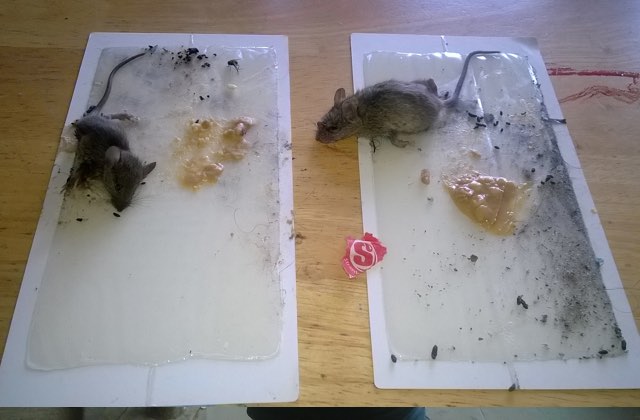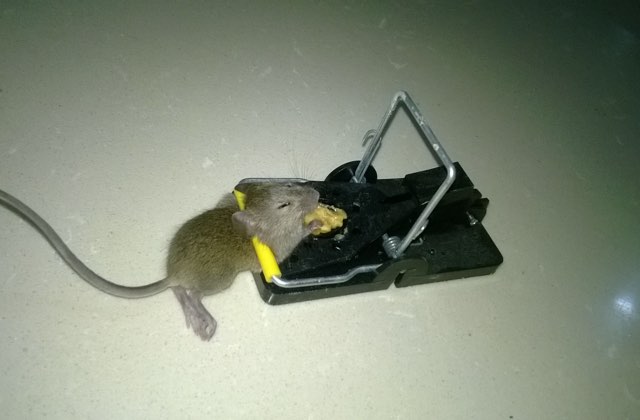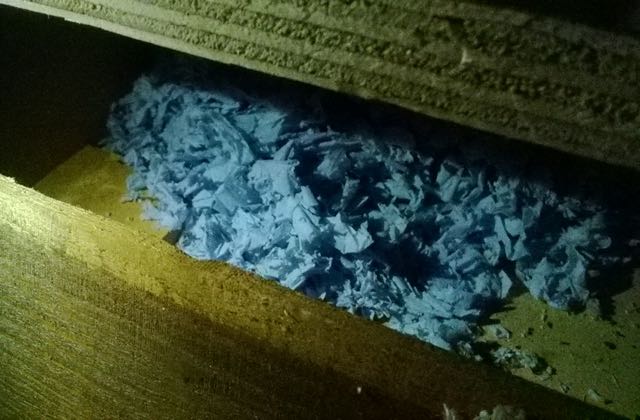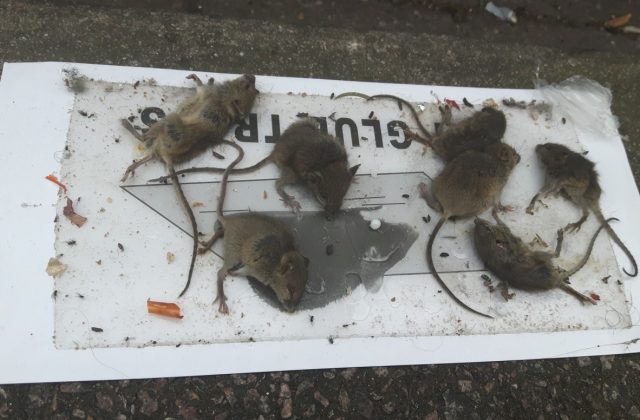Mice are a serious pest whose numbers need to be controlled for many reasons. They eat food and contaminate it with urine and excrement. They gnaw into materials such as paper, books, wood or upholstery which they use as nest material. They also gnaw plastic, soft metals such as lead and aluminum, and electrical wires where they live such as under floorboards. – potentially dangerous for numerous reasons. Mice, or the parasites they carry, (such as fleas, mites and worms) spread many diseases. They are not pleasant to live with, causing a fair bit of distress to the host. They are also prolific breeders, for instance a female mouse can have up to 84 young per year. Rodents also start breeding again at the age of six weeks, so after a year you could end up with over a thousand mice from a breeding pair.
What are the signs of an infestation?
- Droppings – Mouse droppings are black, rod shaped and about 3 – 6 mm long, each mouse can leave about 80 droppings per day. Common places to find droppings are under the kitchen sink, around central heating boilers and in roof spaces.
- Smears – These are dark grey marks left on surfaces by repeated contact with the oils on mouse fur.
- Nests – Sometimes nests can be found indoors. For example in lofts, under floorboards, in airing cupboards or the backs of fridges.
- Gnawing – Mice gnaw continually on materials such as wood, carpet, paper, pipes, electrical wires, cardboard packaging.
Why must mice be controlled?
Apart from the damage to property caused by gnawing mice spread diseases such as salmonella and listeria. Also as mice make no distinction between where they defecate and where they eat, their faeces will cause food poisoning and upset stomachs.
How can I prevent an infestation?
Householders can take steps to prevent mouse infestation by taking a number of simple precautions.
- Keep your home in good repair. Mice only need a gap the diameter of a pencil to gain entry. Seal any gaps in your homes outside walls.
- Seal any gaps around heating and water pipes.
- Ventilation bricks and slots should have a fine wire mesh incorporated. 3.15mm mesh works best.
- Remove potential nesting sites by keeping yards and gardens clean and tidy – cutting back overgrown areas.
How can I get rid of mice?
It’s important to get rid of mice as soon as possible as they are prolific breeders and the situation can soon get out of control if left unchecked. It is possible to carry out the work yourself using poison or break back traps – however, a professional pest control expert will always have more technical expertise and access to rodenticides that are not available to the general public.
FAQ
What are the signs that I have mice in my house?
Mice leave lots of clues around your home that can tip you off to their presence. These signs include mouse droppings, which look like dark brown, almost black grains of rice. They also have a need to gnaw to keep their teeth short, so you may see chewing marks on skirting boards, cardboard boxes, rice or flour, or cereal packets and even furniture. You may hear mice scrabbling around in walls or in your loft, or squeaking noises. In heavy infestations you may notice a strong musty odour.
How quickly do mice breed
The gestation period is about 19–21 days, and they give birth to a litter of 3–14 young (average six to eight). One female can have 5 to 10 litters per year, so the mouse population can increase very quickly. Breeding occurs throughout the entire year. Basically a female mouse can have as many as 150 offspring a year. So if you spot a mouse in your home it’s safe to assume there are more – or there will be soon.
Are mice nocturnal?
House mice are mainly nocturnal, although at some locations considerable daytime activity may be seen. Seeing mice during daylight hours does not necessarily mean that a high population is present, although this is usually true for rats.
Life span:
1-1/2 to 3 years. 2 years being the average. Wild mice live longer, around 5 years in captivity, though only around 6 months in the wild due to predators and environmental factors). Maturity: 4 – 8 weeks of age, varying from species to species and mouse to mouse. Mice can survive long periods when water is scarce. Most of their water requirements can be met by the food they consume. Mice do not have a need to go outside and be exposed to predators.
Where do they live:
Mice live in every country on Earth, and they typically make their homes in a variety of man-made structures, including farms, mines, houses, warehouses and offices. Wild mice live in a broad variety of outdoor areas, including arable land, pastures, coastal dunes and plains, marshes and forests. The changing of the season can affect habitat, causing outdoor mice attempt to move into indoor areas with more warmth and shelter. In your home they can typically be found behind your kitchen kickboards, under floorboards, between floors, at the back of your fridge, in the loft and even in your bed base or inside your sofa.
What do mice eat? In a word, anything: The technical term is omnivorous. The list is too long to detail but includes fruits, vegetables, grains, insects, cereals, sweets, crisps. Literally anything . . . they do prefer some foods over others just the same as people do but funny enough one food they don’t prefer is cheese. Most mice will turn their nose up at cheese if there is another food source.
Can mice jump? – Yes – they can jump vertically about 10 inches
Can mice climb? – Yes. We have traced their movements by using luminous dust and found they can climb pipes, up serving trolleys, across ropes, up brickwork. Pretty much anything that is climbable.
How did they get in my home?
Mice have the physical ability to squeeze in tiny spaces under doors. Their bodies are flexible enough to almost “flatten” their rib cages, so they could pass through small holes. If they cannot do it, they are persistent enough to chew their way into your home. Yet, they’d prefer small crevices or cracks somewhere in your property which they could use as an entrance. Or they could simply have walked through an open door and started a family in a quiet corner of your nice warm house
Do they bite people?
Regardless of how terrified some people are of mice, they’re peaceful creatures and won’t crawl into your bed while you’re asleep to bite you. If threatened, maybe if you grab them, they might bite you. Remember, they’re just as terrified as you are. They don’t want human company – they just want your food and warmth.
Mouse diseases
First let’s say that mice not the cleanest living of God’s creatures and are also not constrained by good hygiene practice or etiquette. They will urinate and defecate in the food they are eating. For instance cereal boxes, flour or rice packets. Mice carry over 200 human pathogens, I can’t list them all but here are a few favourites
Bubonic plague – let’s not mess around and go straight in with the big one.
This disease killed around 50 million people (or 60% of the European population) during the 14th century. It has made a few comebacks since then and still remains one of the world’s most unpopular diseases. This disease is spread to humans by fleas. Plague is usually fatal within a few days of infection. It is present in rodents throughout the western United States, and in many other parts of the world.
Salmonella – Mice and rats are both frequent carriers. Spreads to humans by contact with mouse droppings, especially through consumption of contaminated food. Causes serious, sometimes fatal gastroenteritis. Household pets are also frequently infected with Salmonella by this means and often die as a result.
Murine Typhus (typhus transmitted from mice via flea bite) – This disease is treatable with antibiotics, but can cause death in elderly or infirm individuals. Symptoms include vomiting, fever, headache, myalgia, and cough.
Leptospirosis – Rats and mice are both carriers of this potentially fatal disease.
Lymphocytic Chorio-meningitis (LCM) – A rodent-borne viral infectious disease presenting as aseptic meningitis (inflammation of the membrane surrounding the brain and spinal cord) and/or encephalitis (inflammation of the brain itself). Usually, LCM is not fatal (mortality is less than 1%).
Rat-bite Fever – Fatal in 10 percent of untreated cases. Usually contracted from rats, but infection can also occur from mice. The bacterium causing this disease enters the body through bites, as its name suggests, or from urine contaminating either food or preexisting skin wounds.
Tapeworms – Mice host small tapeworms of the genus Hymenolepis that can spread to humans who eat foods contaminated with mouse droppings (or when hands are merely dirtied by droppings and not washed before meals). These parasites hatch out in the gut where they grow and reproduce.
THESE ARE JUST A FEW – A WEALTH OF OTHERS CAN BE FOUND BY GOOGLING “WHAT DISEASES DO MICE CARRY”?
Habits
From a house owner’s point of view the most important fact is that mice teeth are growing continuously. To keep their teeth sharp. A house mouse may gnaw on wood, fabric, metal, foam, plastic and even electrical wires or cabling.
Mice are much like humans in how their bodies and minds work. This is why laboratories use mice as test subjects for medicines and other items that may be used on humans. Nearly all modern medicine is tested on mice before they go to human medical trials.
A mouse’s heart can beat 632 beats per minute. A human heart only beats 60 to 100 beats per minute.






